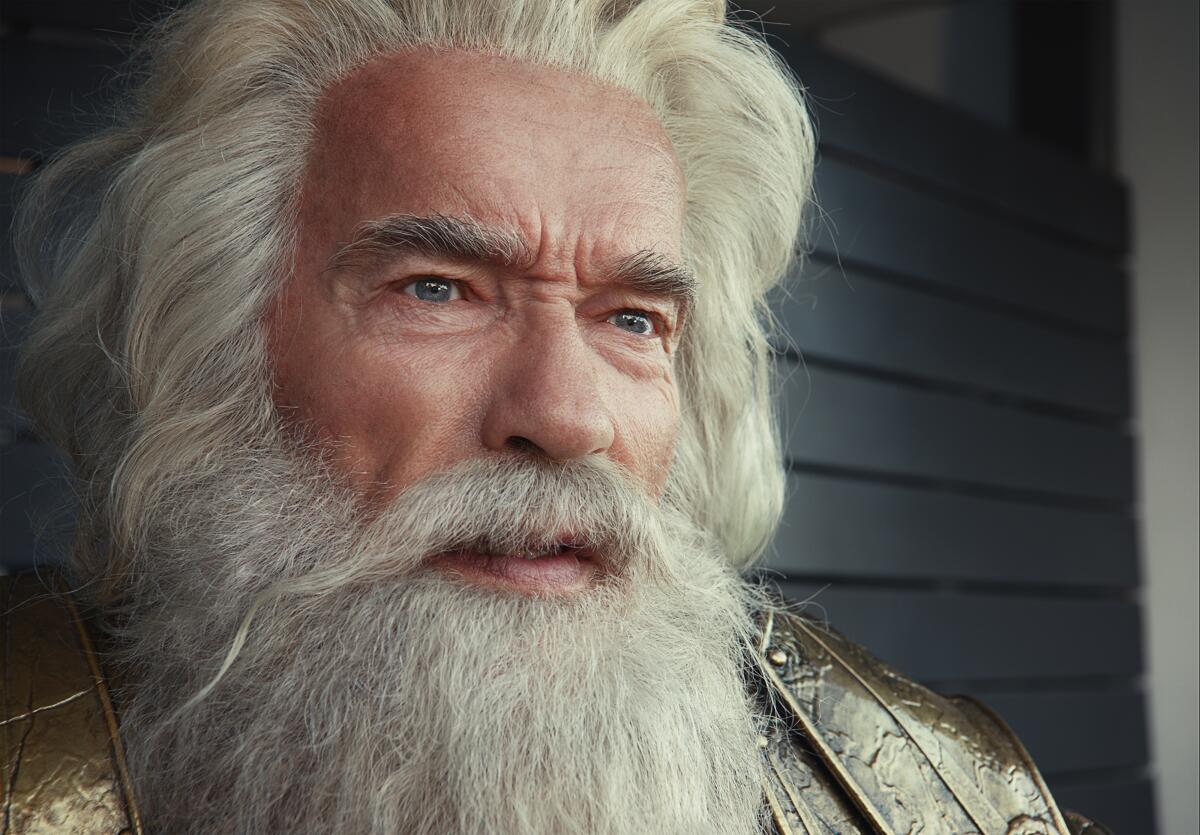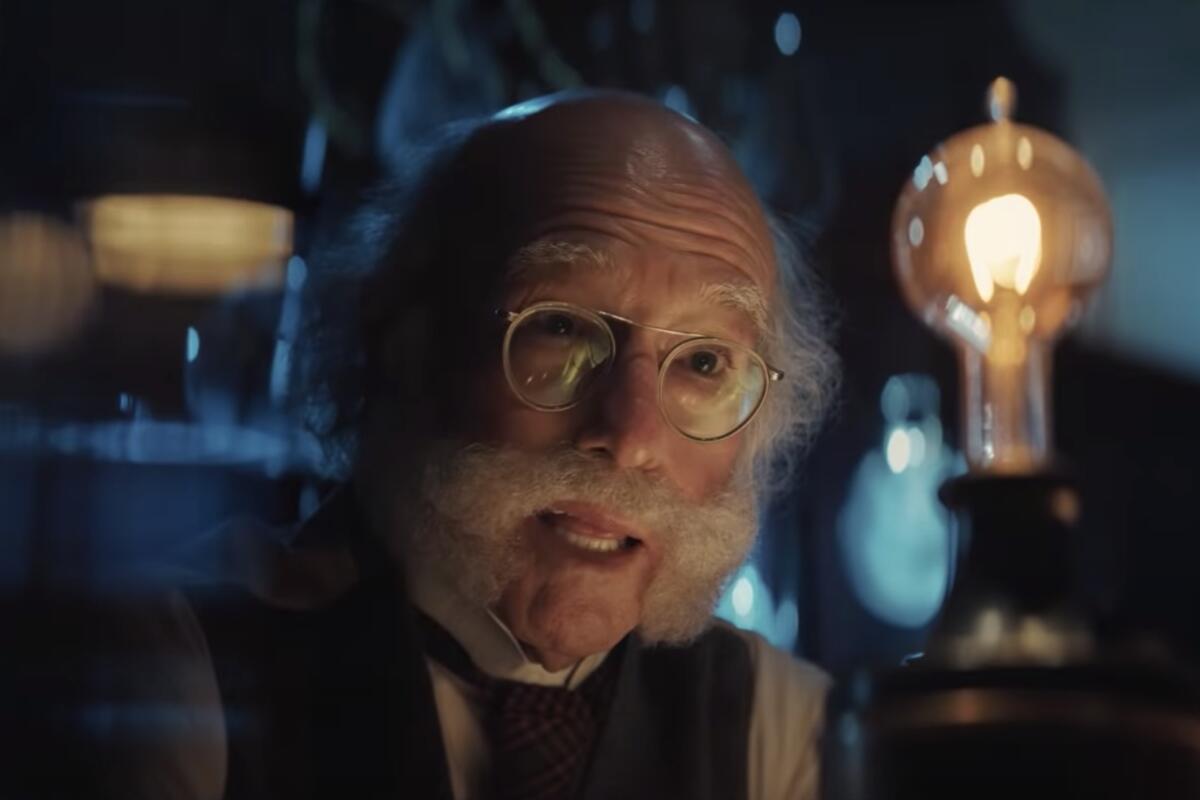Crypto, clean cars and Arnold: Super Bowl ads on the climate crisis

- Share via
This is the Feb. 17, 2022, edition of Boiling Point, a weekly newsletter about climate change and the environment in California and the American West. Sign up here to get it in your inbox.
I should start with a confession: I didn’t watch the Super Bowl. At least, not until the final two minutes, when I tuned in just in time to see the Los Angeles Rams score a late touchdown and claim victory over the Cincinnati Bengals in Inglewood.
But although I don’t especially care about football, you can count me in for Super Bowl ads showcasing climate solutions.
There were a whole bunch this year, mostly promoting electric vehicles. Mike Myers reprised his role as Dr. Evil from “Austin Powers” to hawk clean cars for General Motors. The Swedish automaker Polestar invoked 19-year-old climate activist Greta Thunberg. Arnold Schwarzenegger and Salma Hayek played the Greek gods Zeus and Hera in a spot for BMW’s iX luxury SUV.
“It was the biggest day of advertising for electric vehicles ever. I don’t think there’s been that many people watching that many EV ads at any previous point in history,” said Duncan Meisel, campaign director for Clean Creatives, which pressures ad agencies to stop working with fossil fuel companies. “It feels like a real indication of where the winds are blowing.”
I asked Schwarzenegger, the former California governor, what he thought about the abundance of electric vehicle ads. He told me he was thrilled to see clean cars spotlighted on such a big platform, with a television audience of over 100 million viewers.
“It was really, I think, a huge, huge breakthrough to see this happening,” Schwarzenegger said.

It wasn’t just car companies getting in on the climate action.
The electric vehicle charging company Wallbox ran an ad featuring a real-life lightning strike survivor. Mayonnaise producer Hellmann’s hired “SNL” star Pete Davidson to get tackled by a football player in an ad decrying food waste (which contributes to climate change). And software company Salesforce — owner of Slack — aired a commercial in which Matthew McConaughey, dressed as an astronaut, ditches a mission to space and returns to his home planet to confront environmental problems.
“It’s not time to escape. It’s time to engage,” McConaughey says, in an ad touting the company’s sustainability efforts.
Salesforce also took an indirect swipe at Facebook founder Mark Zuckerberg’s virtual-reality dreams, and at the corporate titans spending billions of dollars on space exploration — here’s looking at you, Jeff Bezos, Richard Branson and Elon Musk.
“While the others look to the metaverse and Mars, let’s stay here and restore ours,” McConaughey says.
Several other Super Bowl ads promoted cryptocurrency, which purports to be a digital version of money. I’m mentioning this because the process of creating new bitcoin and other types of cryptocurrency — known as “mining” — is carried out by high-powered computers that use huge amounts of energy. Researchers at the University of Cambridge estimate that bitcoin mining consumes about 125 terawatt-hours of electricity annually — almost as much power as used by Sweden’s 10 million residents.
Some of that energy comes from renewable sources, but much of it is generated by fossil fuels. Just last week, I reported that a coal-fired power plant in Montana has found new life supplying bitcoin miners. And although some cryptocurrency firms support efforts to switch to clean power, that may not be easy — and the more electricity society uses as a whole, the harder and more expensive it will be to build enough solar panels, wind turbines and other clean technologies to eliminate climate pollution.
I was especially struck by the Super Bowl ad for cryptocurrency exchange FTX, mostly because it starred “Curb Your Enthusiasm” and “Seinfeld” creator Larry David. (I’m a big “Curb” fan.) A time-hopping David dismisses various technological breakthroughs throughout history, at one point giving Thomas Edison his evaluation of the light bulb: “Can I be honest with you? It stinks.” The ad ends with Larry showing similar skepticism toward cryptocurrency, and insisting, “I’m never wrong about this stuff. Never.”
The whole thing made me laugh. But why was David — an avowed environmentalist who launched the “Curb Global Warming” sweepstakes and once called climate change “the big indignity of modern life” — shilling for energy-hungry crypto?
I posed the question to David through his talent agency, WME; he didn’t provide a comment.
FTX, for its part, says it’s invested in carbon removal technology, taken steps to limit energy use and spent millions of dollars on carbon offsets (a potentially useful but frequently problematic tool). Chief Executive Sam Bankman-Fried told me concerns about crypto’s climate impacts are “legitimate points to bring up, and I think there are a lot of things that can be done to mitigate that.”

But enough about bitcoin. Let’s go back to car company ads, of which there were at least eight during the Super Bowl:
- General Motors: “Austin Powers” villain Dr. Evil completes a takeover of GM, only to be told by his minions there’s no point in world domination without saving the world first — hence the need to “reduce our carbon footprint,” as Mindy Sterling’s character tells Mike Myers. This is the second time the largest U.S. auto manufacturer has used the Super Bowl to promote its plan to introduce 30 electric cars by 2025, following last year’s spot starring Will Ferrell, which I wrote about at the time.
- Chevrolet: The GM subsidiary riffed on “The Sopranos,” re-creating the show’s opening sequence with Jamie-Lynn Sigler (Meadow Soprano) behind the wheel of an electric Chevy Silverado instead of the gas-guzzler her TV dad once drove.
- Polestar: You may not have heard of this electric car company; it’s a joint venture between Sweden’s Volvo and the Chinese firm Geely, and my colleague Russ Mitchell has described its latest model as “the first true direct competitor to the Tesla Model 3.” The Super Bowl ad for the Polestar 2 shuns celebrity endorsements, instead promising “no greenwashing, “no dieselgate,” “no compromises,” “no nonsense” and “no conquering Mars” — another not-so-subtle dig at Musk’s space aspirations.
- Kia: This one is pretty cute, following a tiny robot dog as it chases after a Kia EV6. It ends with the driver using the car’s battery to recharge the dog, which has run out of juice — a reminder that EV batteries can keep homes powered during blackouts.
- BMW: This one might be my favorite, although I’m biased because it takes place in Palm Springs, where I enjoyed living for several years. Schwarzenegger and Hayek — aka Zeus and Hera — have retired to the resort city, where the god of thunder grows increasingly frustrated with desert life until Hayek gifts him an electric SUV, which gets the electricity crackling through his veins. They drive through downtown, with Schwarzenegger shooting bolts of lightning to turn all the stoplights green.
- Nissan: I’m not going to attempt to explain the plot of this ad, which involves Eugene Levy becoming an action star. It mostly revolves around a gasoline vehicle anyway, although it ends with a plug for the Nissan Ariya, an all-electric crossover SUV.
- Porsche: The automaker’s “Top Gun”-inspired commercial, starring Tom Cruise, was not focused on electric cars. But it did briefly feature two EVs: the Taycan Turbo S and the Mission R (the latter is a prototype not ready for production).
- Toyota: Toyota was the only car company not to promote electric vehicles, choosing instead to hype its Tundra pickup truck.
Schwarzenegger wasn’t too surprised to see Toyota as an outlier, reminding me the Japanese automaker sided with President Trump during a fuel-efficiency spat with California. But Toyota has started to change its tune, saying it will launch 30 electric models by 2030. Schwarzenegger thinks the growing demand for EVs has given Toyota and other manufacturers little choice.
“The technology is getting better and better. People feel more and more comfortable,” he said.
It’s definitely a good time to be in the electric car business. Zero-emission vehicles accounted for 12% of total sales in California last year, and the Biden administration is planning to distribute $5 billion in funding for EV chargers. All those Super Bowl ads could help speed the transition: Cars.com said after the big game that it saw an 80% increase in electric vehicle pageviews.
To Schwarzenegger, the commercials were so effective in part because they (mostly) didn’t discuss climate change.
The “Terminator” star told me he was drawn to the BMW ad not only because it was funny, but also because it didn’t make people feel guilty for not driving electric cars. He thinks the environmental movement could learn from this kind of messaging.
“Fear and threats and all this stuff doesn’t work. We have to bring people in and make them be part of the solution,” he said.

Schwarzenegger also thinks messaging about planet-warming carbon emissions is less effective than messaging about traditional air pollution, which comes from many of the same sources and kills an estimated 7 million people worldwide every year.
“We have to educate the general public, and we have to communicate better with the general public — not talking about climate change, because no one understands what the hell we’re talking about, but talk about [how] we have to get rid of pollution,” he said. “And here are the things we can do to get rid of pollution, and one of the things that you can do is drive [electric] cars.”
My own take is that different messages resonate differently with different audiences, and there’s an urgent need for all kinds of climate stories — stories of hope, despair, carbon, clean air, clean cars and everything in between.
Some people will read about the dangers of extreme heat or sea level rise and demand that politicians take action. Some will see two of their favorite movie stars zipping through Palm Springs in an electric SUV and get excited about doing the same. Others will (rightfully) point out that technology alone isn’t enough to solve the climate crisis, and that lifestyle changes are crucial too.
Personally, I enjoyed the Salesforce ad — mostly because it reminded me of one of my favorite films, “Wall-E.” The Pixar classic takes place on a 29th century version of Earth that has been environmentally devastated by corporate greed, forcing humans to flee en masse for outer space. The movie ends — spoiler alert — with people returning to Earth and beginning the hard work of creating a healthier world. A gorgeous end-credits song by Peter Gabriel, “Down to Earth,” features the following lyrics:
We’re coming down to the ground
There’s no better place to go
We’ve got snow up on the mountains
We’ve got rivers down below
We’re coming down to the ground
To hear the birds sing in the trees
And the land will be looked after
We send the seeds out in the breeze...
On that note, here’s what else is happening around the West:
TOP STORIES

Sunday’s Super Bowl was the second-hottest ever played, with a kickoff temperature of 82 degrees. Although it’s not yet clear what role climate change may have played, my colleague Alex Wigglesworth reports that global warming is making this kind of winter heat wave far more likely. There were record temperatures across the region — and as much as Southern Californians enjoyed the unseasonable weather, it also made many of us stressed about the climate reality, as Debra Kahn writes for Politico.
New research finds the last 22 years have been the worst drought in the American West in at least 1,200 years. Details here from The Times’ Ian James, including these scary stats: The drought is estimated to be 42% worse because of climate change, and there’s a roughly 75% chance it lasts another eight years. The combination of heat, drought and Santa Ana winds fueled two February fires in Southern California last week, prompting Orange County’s fire chief to lament, “We no longer have a fire season. We have a fire year.” Up north, the Sacramento Bee’s Dale Kasler reports that Pacific Gas & Electric is moving forward with plans to prevent fire ignitions by burying 10,000 miles of high-risk power lines — an effort the company estimates will cost $25 billion.
New legislation in the California Legislature would end offshore oil drilling in state waters. Eleven oil leases would be affected, and the state would have to pay the operators of active oil platforms for what they’re worth, The Times’ Phil Willon reports. The bill could reduce the risk of oil spills like the one last October, and also help slash the planet-warming emissions that cause sea level rise — yet another threat to the California coast. New research shows California could see as much as 8 inches of sea level rise over the next 30 years, worsening storm surges and inundating coastal homes, my colleague Hayley Smith reports.
WATER IN THE WEST
It’s been pretty obvious for years that California’s water laws were not built for the 21st century. Now a group of leading legal experts has a proposal to fix them. Here’s the story from Ian James, who explains the proposal for better monitoring of water withdrawn from rivers, stronger safeguards for low-income communities of color and a sharper focus on today’s climate reality in determining water rights. On a similar theme, my colleague Robert J. Lopez reports that equipment failures and human error likely caused a massive sewage spill on a dry day in Los Angeles last summer — not especially encouraging given that a future of more intense, climate-fueled storms is on the horizon. Our water systems need to be updated for the climate change era, and fast.
The Metropolitan Water District of Southern California could spend more than $60 million buying water from rice farmers and other agricultural interests in the Sacramento Valley this year. The agency has often turned to upstate farmers to bolster local water supplies, and it shows no signs of stopping, the Sacramento Bee’s Dale Kasler reports. And speaking of the Sacramento Valley, I enjoyed this story by Reuters’ Daniel Trotta and Nathan Frandino, about hatchery-born salmon being turned loose in flooded rice fields and growing strong on “zoop soup.” It’s an experiment in floodplain restoration, with encouraging results.
San Diego County Water Authority “maintains hope that demand will eventually rise with population growth.” So writes the San Diego Union-Tribune’s Joshua Emerson Smith, in a fascinating story about the balance between securing reliable water supplies and keeping water bills affordable. San Diego has spent billions of dollars on desalination, recycling and water deals with the Imperial Irrigation District — but with demand continuing to fall due to efficiency and conservation, water rates are rising.
AROUND THE WEST

There are few laws more controversial than the California Environmental Quality Act. The landmark legislation has been used for decades to force government agencies to make decisions that don’t worsen climate change and other environmental calamities, but critics say it’s increasingly become a tool for NIMBY homeowners to block badly needed new housing. That’s certainly the case in Berkeley, as far as Times columnist Anita Chabria is concerned. She writes that CEQA “has been misused over a half-century, morphing into a favorite weapon for maintaining the statewide status quo, and, in so doing, crushing equity.”
It’s totally bizarre to me that the West’s checkerboard pattern of land ownership has resulted in multiple legal controversies over “corner crossing.” That’s the practice of hunters, bird-watchers and others crossing from one checkerboard square of public land to another at a diagonal to avoid private land — a delicate maneuver that has gotten at least a few folks in trouble for violating the airspace above private land in Wyoming, Kylie Mohr reports for High Country News. You can’t make this stuff up. Also bizarre to me: It’s less expensive to graze cattle on public lands now than it was in 1981. Here’s Kylie Mohr again.
Utah Sen. Mike Lee briefly blocked the designation of a former Japanese American internment camp in Colorado as a national historic site. The bill would have passed via unanimous consent had the Republican senator not objected, saying he opposed the addition of any new federal lands without adequate funding, as James Anderson and Sam Metz report for the Associated Press. Lee and Colorado Sen. Michael Bennet ultimately struck a deal, per Colorado Public Radio’s Megan Verlee.
THE ENERGY TRANSITION
The Golden State is likely to need 120 gigawatts of new clean-power capacity by 2040, with nearly half of that coming from solar. That’s according to a new report by the California Independent System Operator, as Rob Nikolewski reports for the San Diego Union-Tribune; for reference, California currently has about 80 gigawatts of in-state generating capacity. All that new power will take up a lot of land, which is why Times columnist George Skelton says California should turn some of its alfalfa fields and nut orchards into solar farms. It’s an idea I’ve written about before, and it’s already starting to happen in the San Joaquin Valley.
There was another malfunction at California’s Moss Landing, home to the world’s largest lithium-ion battery storage installation. Unlike the previous overheating incident at the Vistra Corp. energy facility — which has resulted in the original 300-megawatt battery being mostly offline for months — the latest malfunction affected the 100-megawatt battery expansion. Firefighters on the scene said they found roughly 10 battery packs were melted, Josh Copitch writes for television station KSBW.
“They tell me McDonald’s releases more carbon at the soda fountain than all of the coal plants in the United States.” That is an actual statement made by a member of Montana’s Public Service Commission, which regulates utility companies, as reported by Tom Lutey for the Billings Gazette. The statement doesn’t bear any resemblance to the truth, but it does help explain why Montana officials have no problem pushing utilities to invest in coal power even as investors increasingly shun the fossil fuel.
TWO MORE THINGS

I reported earlier this month that the California Public Utilities Commission intends to fine Southern California Gas Co. nearly $10 million for using customer money to fight climate action. In a related case, the commission had previously said it wouldn’t fine SoCalGas for a separate series of ratepayer-funded attempts to block climate measures, despite the agency’s own consumer watchdog recommending a $255-million penalty. Now the agency is changing course in that case ... by proposing a $150,000 fine.
I also reported last month on Glendale Water & Power’s plan to spend a quarter-billion dollars upgrading a gas-fired power plant with new combustion engines. After that story was published, three Los Angeles City Councilmembers — Kevin de León, Mitch O’Farrell and Nithya Raman — sent a letter urging their Glendale counterparts not to approve the plan. They also wrote to the L.A. Department of Water and Power, asking the much larger utility to help Glendale address its energy needs without fossil fuels.
The issue came to a head in the wee hours of Wednesday morning — after five-plus hours of debate and public comment — when Glendale City Council voted 3-2 to approve roughly 100 megawatts of new gas power. Mayor Paula Devine led the charge, agreeing with city staff that gas engines will be needed alongside investments in renewable energy to help Glendale keep the lights on.
I wish I hadn’t stayed up so late watching the meeting, though, because the council agreed to come back to the issue in two weeks and consider a motion by Councilmember Dan Brotman — previously an activist fighting the proposed gas engines — to require additional council approvals before the city can move forward with any fossil fuel investments. So the debate is not quite over.
We’ll be back in your inbox next week. If you enjoyed this newsletter, please consider forwarding it to your friends and colleagues.




